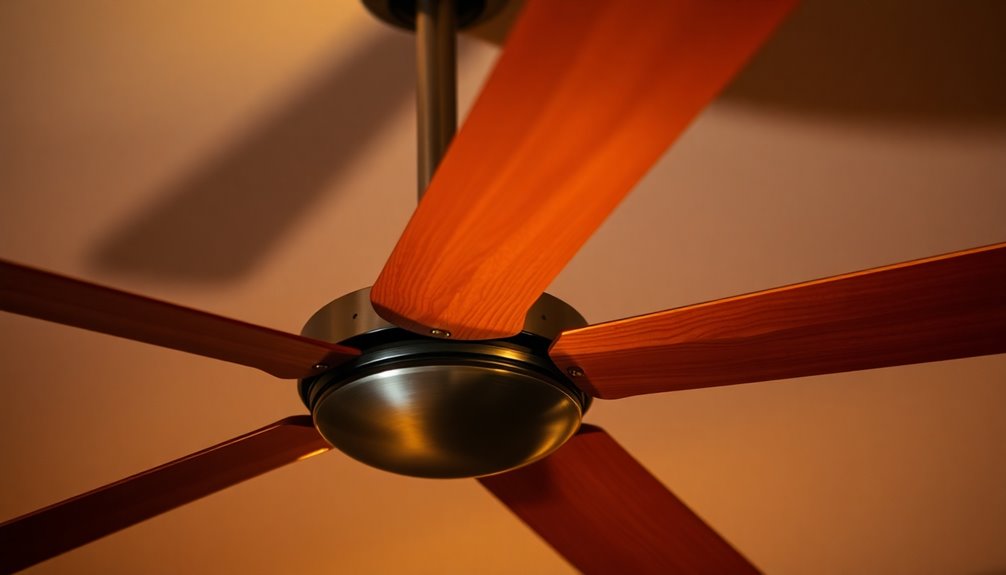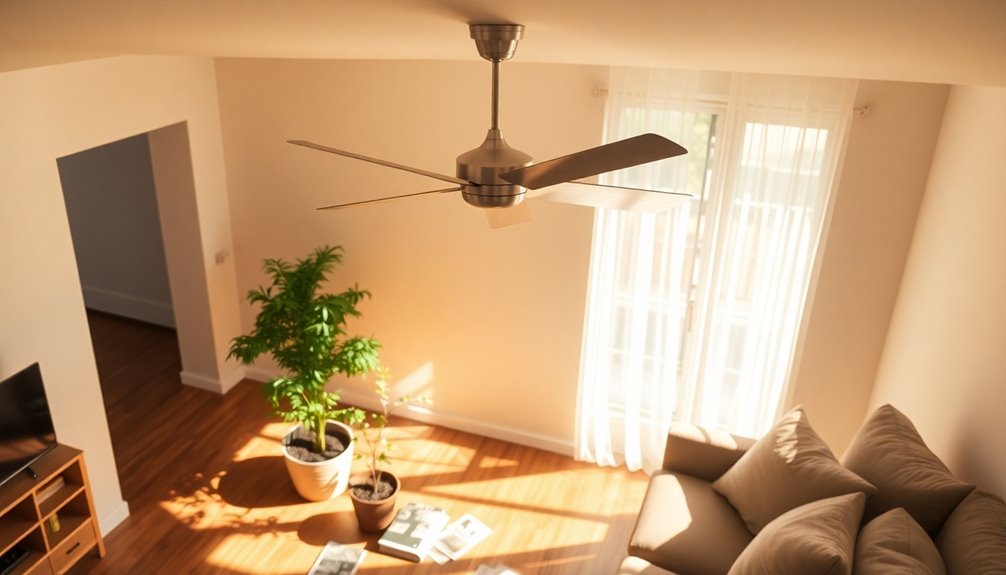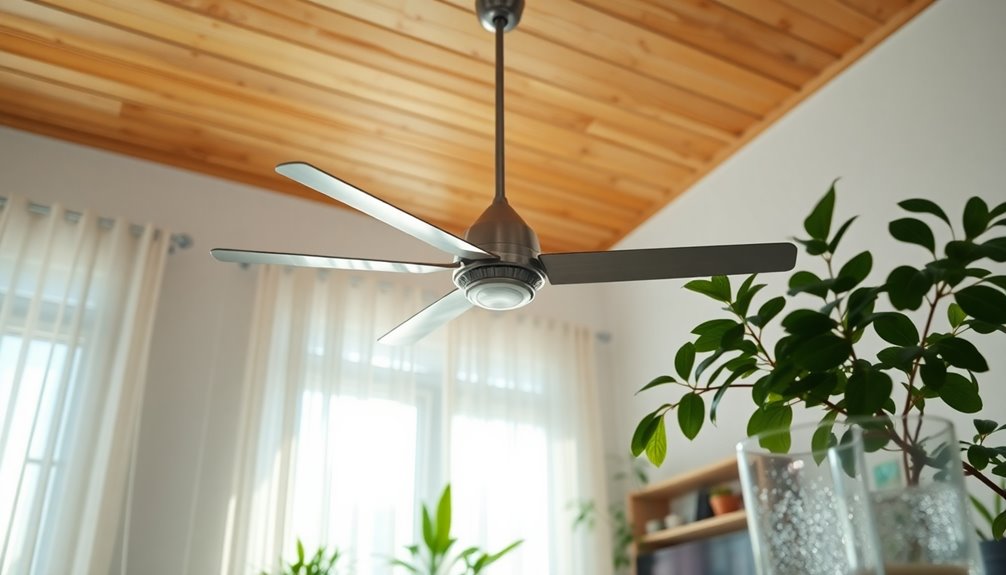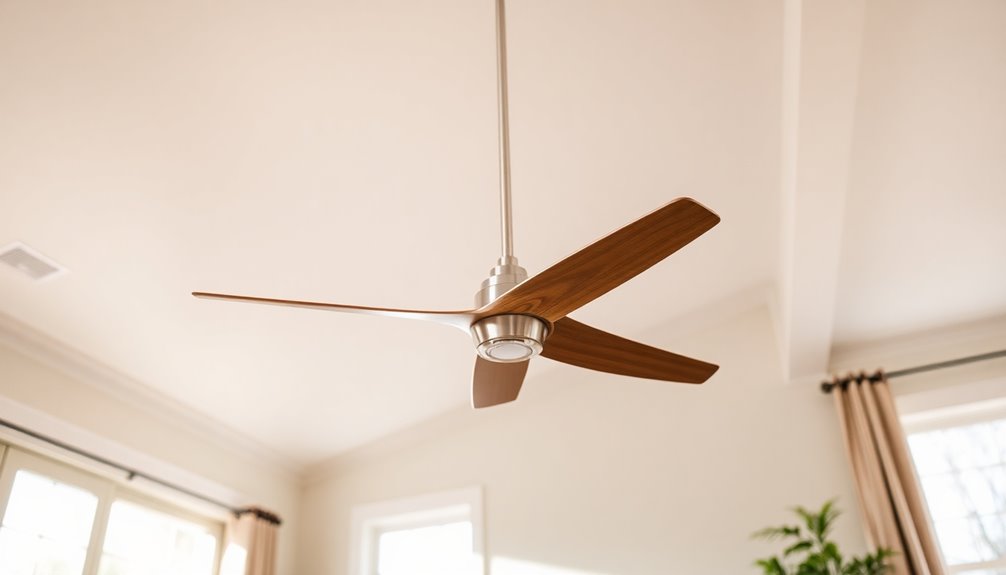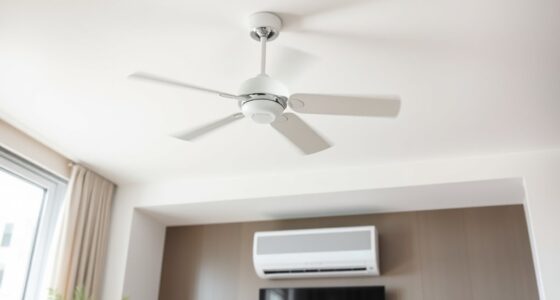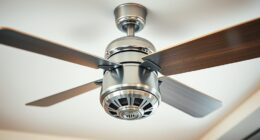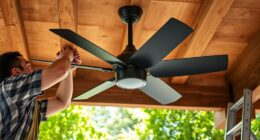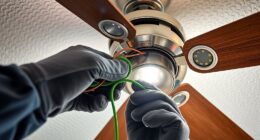To maximize comfort and efficiency, you'll want your ceiling fan to turn counterclockwise in summer. This creates a cooling breeze that can make your room feel up to 8°F cooler, allowing you to raise your thermostat settings. In winter, switch it to clockwise to circulate warm air, helping maintain an even temperature and preventing cold spots. Adjusting the direction seasonally not only enhances comfort but can also lower your energy costs considerably. If you're curious about the best practices for different rooms or maintenance tips, there's plenty more to explore!
Key Takeaways
- Ceiling fans should rotate counterclockwise in summer to create a cooling downdraft.
- In winter, fans should turn clockwise to circulate warm air effectively.
- Adjusting the fan direction seasonally enhances comfort and energy efficiency.
- Most fans have a reversing switch or remote control option to change direction.
- Verify the direction by checking airflow under the fan after adjustment.
Importance of Fan Direction

Understanding the importance of fan direction can greatly enhance your home comfort. By adjusting your ceiling fan switch based on the season, you can improve air circulation in your indoor environment.
In summer, setting your fan to rotate counterclockwise creates a revitalizing cooling breeze, helping you feel cooler without cranking up the air conditioning. This simple adjustment can lead to energy savings of up to 30%, allowing you to lower your thermostat settings while staying comfortable.
Conversely, during winter, switching your fan to clockwise produces an updraft that circulates warm air, preventing cold spots and maximizing heating efficiency. This adjustment can save you around 15% on heating costs, making it a smart choice for your wallet.
When you neglect to change the fan direction, you're likely to experience inadequate airflow, resulting in discomfort and higher energy bills.
By regularly adjusting your ceiling fan according to the season, you enhance the effectiveness of your HVAC system and maintain an ideal indoor environment. Additionally, this practice complements the use of energy-efficient heat pumps, further optimizing your home's climate control and savings.
Seasonal Direction Guidelines

To keep your home comfortable year-round, it's essential to adjust your ceiling fan's direction with the seasons.
In summer, set it to rotate counterclockwise for a revitalizing breeze, while in winter, switch it to clockwise to circulate warm air.
Making these changes not only enhances your comfort but can also lead to significant energy savings.
Summer Cooling Direction
During the summer months, setting your ceiling fan to rotate counterclockwise is crucial for maximizing comfort in your living space.
This ceiling fan direction creates a cooling downdraft that enhances airflow and helps you beat the heat. By spinning counterclockwise, the fan can make a room feel up to 8 degrees cooler, allowing you to raise your thermostat settings and reduce reliance on air conditioning.
The wind chill effect produced by this rotation improves comfort levels without actually lowering the room's temperature. When you run your fan at high speed in summer, you can achieve energy savings of up to 30%.
This means you can comfortably increase your air conditioning thermostat settings by up to 4 degrees, which helps lower your energy bills. Additionally, using a ceiling fan effectively can lead to lower energy bills and create a more pleasant living environment.
To verify you're getting maximum cooling, stand directly under the fan and feel for airflow. You should feel a strong downdraft blowing directly downwards when the fan is set to counterclockwise.
Make this simple adjustment, and enjoy a cooler, more comfortable living space all summer long while saving energy!
Winter Heating Direction
When winter arrives, adjusting your ceiling fan to rotate clockwise can make a significant difference in your home's comfort. This ceiling fan direction creates a gentle updraft that helps redistribute warm air that naturally rises to the ceiling.
By running the fan at a low speed during winter, you prevent drafts while effectively circulating warm air throughout the room.
To verify your fan is spinning clockwise, stand directly underneath and check for minimal air movement.
You'll notice that this seasonal adjustment not only maintains a comfortable indoor environment but also promotes energy savings. Homeowners can reduce their thermostat settings without sacrificing warmth, leading to utility bill reductions of 15% or more.
How to Change Direction

To change the direction of your ceiling fan, first, make sure it's turned off and completely stopped.
If you have a pull chain fan, find the reversing switch on the fan body to switch between the directions.
For remote-controlled fans, just turn it off, then press and hold the fan button on the remote until you see the light blink, indicating the change.
Pull Chain Method
Changing the direction of a pull chain ceiling fan is a straightforward process that can enhance your comfort at home.
First, you'll want to turn off the fan and verify it comes to a complete stop for safety. This step is essential to avoid any accidents while you adjust the fan operation.
Next, locate the reversing switch, which is typically found near the pull chains or on the motor housing. Once you've found it, pull the chain or toggle the switch to change the direction of the fan. Usually, one pull will switch it from counterclockwise to clockwise or vice versa.
After making the adjustment, turn the fan back on to confirm it operates in the newly set direction.
Regularly checking and adjusting the fan direction with the pull chain seasonally can optimize your comfort and improve energy efficiency in your home.
When your ceiling fan runs in the correct direction, it helps distribute air effectively, keeping your space comfortable year-round.
Remote Control Adjustment
If you've got a remote-controlled ceiling fan, adjusting its direction is simple and quick. First, make sure your ceiling fan is turned off and has completely stopped spinning.
Most remote controls feature a dedicated reverse option. Press and hold this button to toggle the fan direction between clockwise and counterclockwise settings.
When you successfully change direction, you'll notice a blinking light on the remote, confirming that the command has been received by your fan.
If you own a smart fan, you might've the added convenience of adjusting fan direction through an app or by using voice commands, which can make life even easier.
Always refer to your specific fan's manual for detailed instructions, as different models may have unique features that affect how you make these adjustments.
Knowing how to effectively change direction can greatly enhance your comfort and energy efficiency.
Whether you're looking to turn clockwise for winter warmth or turn counterclockwise for summer cooling, mastering the remote control adjustments will help you maximize your ceiling fan's performance.
Timing for Direction Change

As the seasons shift, it's essential to evaluate the ideal timing for changing your ceiling fan's direction. A good rule of thumb is to make these adjustments during Daylight Savings Time changes—when you spring forward in the spring or fall back in the autumn. This practice guarantees that your ceiling fan direction aligns with the seasonal needs of your home.
For the summer months, set your fan to rotate in a counterclockwise direction. This creates a cooling downdraft that helps you feel comfortable without cranking up the AC.
In contrast, during winter, change the direction to fan clockwise. This will create an updraft, redistributing warm air and enhancing your heating efficiency.
To maximize your fan's performance with these seasonal adjustments, consider the following:
- Adjust your fan direction at the start of each season.
- Monitor the ceiling fan size for peak efficiency.
- Create a cooling and heating balance in your home.
- Improve energy efficiency by choosing the right settings.
- Enjoy enhanced comfort levels year-round.
Regularly changing the direction of your ceiling fan can make a significant difference in your home's comfort and energy consumption.
Ceiling Fan Direction in Summer

To beat the summer heat, set your ceiling fan to rotate counterclockwise. This direction creates a cooling downdraft that enhances airflow, making your space feel up to 8 degrees cooler. When you run your fan this way, you can even adjust your thermostat settings up by 4 degrees, leading to energy savings of up to 30%. The wind-chill effect generated by the counterclockwise rotation helps reduce reliance on air conditioning, lowering your energy bills while keeping you comfortable.
Here's a quick overview of the benefits of setting your ceiling fan to rotate counterclockwise in summer:
| Benefit | Description | Impact |
|---|---|---|
| Cooling Downdraft | Creates a revitalizing airflow | Feels up to 8°F cooler |
| Energy Savings | Allows higher thermostat settings | Up to 30% savings |
| Wind-Chill Effect | Enhances comfort without AC reliance | Lower energy bills |
| Improved Airflow | Maximizes circulation throughout the room | Better comfort |
Ceiling Fan Direction in Winter

Setting your ceiling fan to rotate clockwise during winter can make a significant difference in your home's comfort and energy efficiency. By adjusting the ceiling fan direction to spin clockwise, you can create a gentle updraft that redistributes warmer air trapped near the ceiling back down into your living space. This simple change helps to evenly circulate warm air without causing cold drafts.
Here are some benefits of using your ceiling fan in winter:
- Enhances comfort by reducing cold spots in the room.
- Lowers heating costs through energy savings of up to 15%.
- Allows for lower thermostat settings, maintaining warmth effectively.
- Prevents reliance on heating systems, promoting energy efficiency.
- Creates a more consistent temperature throughout your space.
To confirm that your fan is rotating clockwise, stand underneath and observe the blades moving from the top left to the bottom right.
Running the fan at low speed will help maintain a comfortable atmosphere while ensuring that warmer air is effectively circulated, making your winter months cozier and more cost-effective.
Switch to the clockwise setting and enjoy a warm, inviting home all season long!
Direction for Specific Rooms

Choosing the right ceiling fan direction for specific rooms can enhance comfort and efficiency throughout your home. Here's how you can optimize your ceiling fan settings for various spaces:
| Room Type | Recommended Direction and Speed |
|---|---|
| Dining Room | Clockwise at medium or low speed to avoid cooling breeze and maintain food temperature. |
| Home Office | Clockwise at medium speed to prevent papers from blowing around, ensuring a comfortable work environment. |
| Vaulted Ceilings | Spin counterclockwise year-round for consistent airflow while minimizing wind chill. |
| Smokers' Rooms | Clockwise setting to draw smoke upward, aiding in ventilation when windows are open. |
| Outdoor Spaces | Rotate counterclockwise at high speed to create a cooling effect and deter insects. |
General Ceiling Fan Tips

Maximizing the benefits of your ceiling fan involves more than just adjusting its direction.
To truly enhance comfort and efficiency, you need to take into account several factors that influence performance and energy costs.
Here are some tips to help make the most of your ceiling fan:
- Always choose the right size ceiling fan for your room.
- Regularly clean the ceiling fan blades and motor to maintain efficiency.
- Turn off the fan when you leave a room since it doesn't cool the air but creates a wind-chill effect.
- Install a remote control to easily change your ceiling fan direction as needed.
- Confirm the fan direction is set correctly for the season—counterclockwise for cool breezes in summer and clockwise for warmth in winter.
Energy Savings With Ceiling Fans

Saving energy with ceiling fans is easier than you might think. By adjusting the ceiling fan direction, you can maximize your energy savings considerably.
In the summer, set your fan to rotate counterclockwise. This creates a cooling downdraft, allowing you to feel cooler and potentially raise your thermostat settings by about 4 degrees. This simple adjustment reduces your reliance on air conditioning, leading to lower cooling costs and reduced energy bills.
In the winter, running your ceiling fan clockwise at a low speed helps redistribute warm air that collects near the ceiling, allowing you to stay cozy while saving an additional 15% or more on energy.
Since ceiling fans consume only about 50 watts per hour compared to 3,500 watts for air conditioning units, they provide a cost-effective cooling solution year-round.
For even greater energy savings, consider pairing your ceiling fans with ENERGY STAR-rated air conditioning systems. This combination can increase overall energy efficiency by up to 8%.
Frequently Asked Questions
Which Way Should Fans Spin in Summer?
In summer, you want your ceiling fan to spin counterclockwise. This direction creates a cooling downdraft, making you feel up to 8 degrees cooler.
By setting your fan this way, you can run the air conditioning less and save on cooling costs, potentially cutting expenses by up to 30%.
When you stand directly beneath the fan, you'll feel that invigorating breeze, confirming it's doing its job to enhance your comfort.
How Do You Tell if a Fan Blade Is Clockwise or Counterclockwise?
To tell if a fan blade's spinning clockwise or counterclockwise, stand directly beneath it.
As you watch, notice the blades' movement: if they sweep from the top left to the bottom right, it's clockwise. If they move from the top right to the bottom left, it's counterclockwise.
Feel the airflow too; a cooling breeze means counterclockwise, while a gentle updraft indicates clockwise.
You can also check the fan's manual for confirmation.
Which Way Should Switch Be on Ceiling Fan?
To get the most out of your ceiling fan, you should adjust the switch based on the season.
During summer, set it to counterclockwise to create a cooling downdraft. In winter, flip it to clockwise to push warm air down from the ceiling.
This simple adjustment can improve your comfort and help save on energy bills.
Regularly checking the switch will guarantee you're maximizing your fan's efficiency throughout the year.
How Does a Ceiling Fan Work Clockwise or Anticlockwise?
A ceiling fan works by creating airflow, which you can control by adjusting its rotation.
When it spins counterclockwise, you feel a cooling breeze, making it perfect for summer.
In winter, if you switch it to clockwise, it pushes warm air down, helping to keep your space cozy.
Conclusion
To sum up, knowing the right direction for your ceiling fan can make a big difference in your comfort and energy savings. Did you know that running your fan counterclockwise in summer can help reduce cooling costs by up to 40%? By changing the direction based on the season and room usage, you can enjoy a more comfortable environment all year round. So, take a moment to adjust your fan settings and reap the benefits!
